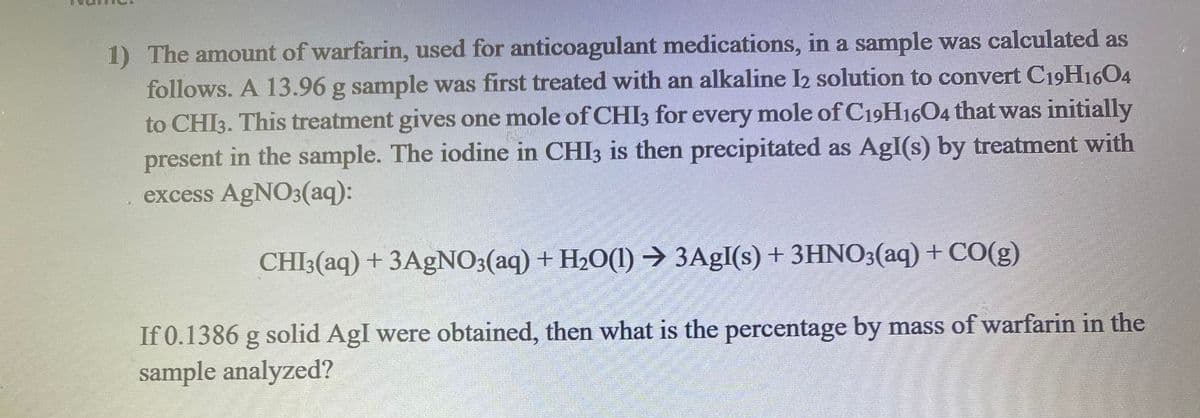1) The amount of warfarin, used for anticoagulant medications, in a sample was calculated as follows. A 13.96 g sample was first treated with an alkaline I2 solution to convert C19H16O4 to CHI3. This treatment gives one mole of CHI3 for every mole of C19H1604 that was initially present in the sample. The iodine in CHI3 is then precipitated as AgI(s) by treatment with excess AgNO3(aq): CHI3(aq) + 3AGNO3(aq) + H2O(1)→ 3AgI(s) + 3HNO3(aq) + CO(g) If 0.1386 g solid AgI were obtained, then what is the percentage by mass of warfarin in the sample analyzed?
1) The amount of warfarin, used for anticoagulant medications, in a sample was calculated as follows. A 13.96 g sample was first treated with an alkaline I2 solution to convert C19H16O4 to CHI3. This treatment gives one mole of CHI3 for every mole of C19H1604 that was initially present in the sample. The iodine in CHI3 is then precipitated as AgI(s) by treatment with excess AgNO3(aq): CHI3(aq) + 3AGNO3(aq) + H2O(1)→ 3AgI(s) + 3HNO3(aq) + CO(g) If 0.1386 g solid AgI were obtained, then what is the percentage by mass of warfarin in the sample analyzed?
Chemistry: An Atoms First Approach
2nd Edition
ISBN:9781305079243
Author:Steven S. Zumdahl, Susan A. Zumdahl
Publisher:Steven S. Zumdahl, Susan A. Zumdahl
Chapter20: Transition Metals And Coordination Chemistry
Section: Chapter Questions
Problem 1ALQ
Related questions
Question
100%

Transcribed Image Text:1) The amount of warfarin, used for anticoagulant medications, in a sample was calculated as
follows. A 13.96 g sample was first treated with an alkaline I2 solution to convert C19H1604
to CHI3. This treatment gives one mole of CHI3 for every mole of C19H1604 that was initially
present in the sample. The iodine in CHI3 is then precipitated as AgI(s) by treatment with
excess AgNO3(aq):
CHI3(aq) + 3AgNO3(aq) + H20(1) → 3A£I(s) + 3HNO3(aq) + CO(g)
If 0.1386 g solid AgI were obtained, then what is the percentage by mass of warfarin in the
sample analyzed?
Expert Solution
This question has been solved!
Explore an expertly crafted, step-by-step solution for a thorough understanding of key concepts.
This is a popular solution!
Trending now
This is a popular solution!
Step by step
Solved in 2 steps with 2 images

Knowledge Booster
Learn more about
Need a deep-dive on the concept behind this application? Look no further. Learn more about this topic, chemistry and related others by exploring similar questions and additional content below.Recommended textbooks for you

Chemistry: An Atoms First Approach
Chemistry
ISBN:
9781305079243
Author:
Steven S. Zumdahl, Susan A. Zumdahl
Publisher:
Cengage Learning


Chemistry
Chemistry
ISBN:
9781305957404
Author:
Steven S. Zumdahl, Susan A. Zumdahl, Donald J. DeCoste
Publisher:
Cengage Learning

Chemistry: An Atoms First Approach
Chemistry
ISBN:
9781305079243
Author:
Steven S. Zumdahl, Susan A. Zumdahl
Publisher:
Cengage Learning


Chemistry
Chemistry
ISBN:
9781305957404
Author:
Steven S. Zumdahl, Susan A. Zumdahl, Donald J. DeCoste
Publisher:
Cengage Learning

Principles of Instrumental Analysis
Chemistry
ISBN:
9781305577213
Author:
Douglas A. Skoog, F. James Holler, Stanley R. Crouch
Publisher:
Cengage Learning


Principles of Modern Chemistry
Chemistry
ISBN:
9781305079113
Author:
David W. Oxtoby, H. Pat Gillis, Laurie J. Butler
Publisher:
Cengage Learning